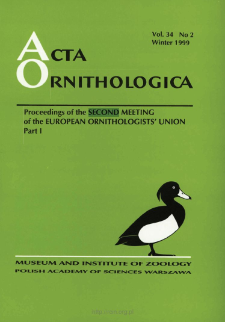- Search in all Repository
- Literature and maps
- Archeology
- Mills database
- Natural sciences
Advanced search
Advanced search
Advanced search
Advanced search
Advanced search

Object
Title: Song functions and territoriality in eurasian treecreeper Certhia familiaris and short-toed treecreeper Certhia brachydactyla
Subtitle:
Acta Ornithologica, vol. 35, no. 1 ; Funkcje śpiewu i terytorialność pełzacza leśnego i pełzacza ogrodowego
Contributor:
Polska Akademia Nauk. Muzeum i Instytut Zoologii ; Meeting of the European Ornithologists' Union (2 ; 1999 ; Gdańsk)
Publisher:
Muzeum i Instytut Zoologii PAN
Place of publishing:
Description:
Referat wygłoszony na Second Meeting of the European Ornithologists' Union ; Bibliogr. p. 114-115 ; P. [109]-116 : ill. ; 27 cm ; Abstract in Polish. Taxa in Latin
Type of object:
Abstract:
The study was conducted in Western Poland during three breeding seasons (1996-1998). Spontaneous song rate changes and playback experiments were used to determine functions of the song in two closely related, sympatric species: Eurasian Treecreeper and Short-toed Treecreeper. Substantial differences in spontaneous song rate and reaction to playback between the studied treecreepers were found. On average Short-toed Treecreeper had a two times higher song rate and longer song bouts than Eurasian Treecreeper. Both species reacted stronger to the playback during the prebreeding and egg-laying stages than during the incubation/feeding stage. Therefore, the primary function of the song in these sibling species is to deter rival males from gaining access to the territory and fertile females. We found no evidence that the song was directly related to mate attraction or stimulation. When reacting to the playback the response patterns differed between the two species, but the overall experimental song response was similar. Interspecific differences in the singing pattern can be explained by dissimilar territorial behaviour. Short-toed Treecreeper bred in clusters, leading to frequent and more ritualized countersinging between rival males. Eurasian Treecreeper territories were scattered and separated by unoccupied habitat. This probably explains why the males rarely sing spontaneously, but behave more aggressively when rivals intrude.
Relation:
Volume:
Issue:
Start page:
End page:
Detailed Resource Type:
Format:
Resource Identifier:
Source:
MiIZ PAN, call no. P.257, Vol. 35, No 1 ; MiIZ PAN, call no. P.4568, Vol. 35, No 1 ; click here to follow the link
Language:
Rights:
Creative Commons Attribution BY 3.0 PL license
Terms of use:
Digitizing institution:
Museum and Institute of Zoology of the Polish Academy of Sciences
Original in:
Library of the Museum and Institute of Zoology of the Polish Academy of Sciences
Projects co-financed by:
Programme Innovative Economy, 2010-2014, Priority Axis 2. R&D infrastructure ; European Union. European Regional Development Fund
Access:
Object collections:
- Digital Repository of Scientific Institutes > Partners' collections > Museum and Institute of Zoology PAS > Scientific Journals
- Digital Repository of Scientific Institutes > Partners' collections > Museum and Institute of Zoology PAS > MIZ PAN Publications > Acta Ornithologica
- Digital Repository of Scientific Institutes > Literature > Journals/Articles
Last modified:
Feb 4, 2025
In our library since:
May 22, 2014
Number of object content downloads / hits:
671
All available object's versions:
https://rcin.org.pl./publication/61273
Show description in RDF format:
Show description in RDFa format:
Show description in OAI-PMH format:
Objects Similar
Thielcke, Gerhard (1931–2007)
Kruszewicz, Andrzej (1959– ) Dyrcz, Andrzej (1933– )
Gryczyńska-Siemiątkowska, Alicja Dolnik, Olga Pawełczyk, Agnieszka Mazgajski, Tomasz D. Siemiątkowski, Marek
Osiejuk, Tomasz S.
Schmidt, Veronika (1973– ) Schaefer, Heinrich Martin Leisler, Bernd
Chylarecki, Przemysław Kuczyński, Lechosław Vogrin, Milan Tryjanowski, Przemysław
Olinkiewicz, Agata Osiejuk, Tomasz S.
Jenni, Lukas

 INSTYTUT ARCHEOLOGII I ETNOLOGII POLSKIEJ AKADEMII NAUK
INSTYTUT ARCHEOLOGII I ETNOLOGII POLSKIEJ AKADEMII NAUK
 INSTYTUT BADAŃ LITERACKICH POLSKIEJ AKADEMII NAUK
INSTYTUT BADAŃ LITERACKICH POLSKIEJ AKADEMII NAUK
 INSTYTUT BADAWCZY LEŚNICTWA
INSTYTUT BADAWCZY LEŚNICTWA
 INSTYTUT BIOLOGII DOŚWIADCZALNEJ IM. MARCELEGO NENCKIEGO POLSKIEJ AKADEMII NAUK
INSTYTUT BIOLOGII DOŚWIADCZALNEJ IM. MARCELEGO NENCKIEGO POLSKIEJ AKADEMII NAUK
 INSTYTUT BIOLOGII SSAKÓW POLSKIEJ AKADEMII NAUK
INSTYTUT BIOLOGII SSAKÓW POLSKIEJ AKADEMII NAUK
 INSTYTUT CHEMII FIZYCZNEJ PAN
INSTYTUT CHEMII FIZYCZNEJ PAN
 INSTYTUT CHEMII ORGANICZNEJ PAN
INSTYTUT CHEMII ORGANICZNEJ PAN
 INSTYTUT FILOZOFII I SOCJOLOGII PAN
INSTYTUT FILOZOFII I SOCJOLOGII PAN
 INSTYTUT GEOGRAFII I PRZESTRZENNEGO ZAGOSPODAROWANIA PAN
INSTYTUT GEOGRAFII I PRZESTRZENNEGO ZAGOSPODAROWANIA PAN
 INSTYTUT HISTORII im. TADEUSZA MANTEUFFLA POLSKIEJ AKADEMII NAUK
INSTYTUT HISTORII im. TADEUSZA MANTEUFFLA POLSKIEJ AKADEMII NAUK
 INSTYTUT JĘZYKA POLSKIEGO POLSKIEJ AKADEMII NAUK
INSTYTUT JĘZYKA POLSKIEGO POLSKIEJ AKADEMII NAUK
 INSTYTUT MATEMATYCZNY PAN
INSTYTUT MATEMATYCZNY PAN
 INSTYTUT MEDYCYNY DOŚWIADCZALNEJ I KLINICZNEJ IM.MIROSŁAWA MOSSAKOWSKIEGO POLSKIEJ AKADEMII NAUK
INSTYTUT MEDYCYNY DOŚWIADCZALNEJ I KLINICZNEJ IM.MIROSŁAWA MOSSAKOWSKIEGO POLSKIEJ AKADEMII NAUK
 INSTYTUT PODSTAWOWYCH PROBLEMÓW TECHNIKI PAN
INSTYTUT PODSTAWOWYCH PROBLEMÓW TECHNIKI PAN
 INSTYTUT SLAWISTYKI PAN
INSTYTUT SLAWISTYKI PAN
 SIEĆ BADAWCZA ŁUKASIEWICZ - INSTYTUT TECHNOLOGII MATERIAŁÓW ELEKTRONICZNYCH
SIEĆ BADAWCZA ŁUKASIEWICZ - INSTYTUT TECHNOLOGII MATERIAŁÓW ELEKTRONICZNYCH
 MUZEUM I INSTYTUT ZOOLOGII POLSKIEJ AKADEMII NAUK
MUZEUM I INSTYTUT ZOOLOGII POLSKIEJ AKADEMII NAUK
 INSTYTUT BADAŃ SYSTEMOWYCH PAN
INSTYTUT BADAŃ SYSTEMOWYCH PAN
 INSTYTUT BOTANIKI IM. WŁADYSŁAWA SZAFERA POLSKIEJ AKADEMII NAUK
INSTYTUT BOTANIKI IM. WŁADYSŁAWA SZAFERA POLSKIEJ AKADEMII NAUK




































